LJMU 7136PS: Terrorism and Counter-Terrorism - ISIS Analysis Essay
VerifiedAdded on 2022/09/08
|22
|6354
|43
Essay
AI Summary
This essay provides a comprehensive analysis of the terrorist group ISIS, addressing its history, ideology, and global impact. The essay begins with an introduction defining terrorism and highlighting the lack of a universally agreed definition, before focusing on ISIS, also known as ISIL. It delves into the group's origins, tracing its roots back to the Salafi Jihadist ideology of Abu Musab al-Zarqawi and its connections to Al-Qaeda. The essay examines the history of ISIS, including the roles of key figures like Abu Bakr al-Baghdadi and the group's funding sources. It then explores the ideology of ISIS, characterizing it as a Wahhabi or Salafi theocracy with a puritanical interpretation of Sunni Islam, and the group's views on those who do not adhere to their beliefs. The essay further analyzes the impact of ISIS, discussing its effects on physical infrastructure, economic markets, and global security, including the group's role in the 9/11 attacks and the broader implications of terrorism on daily life. Finally, the essay concludes with a discussion of the tactics and targets utilized by ISIS to achieve its objectives.
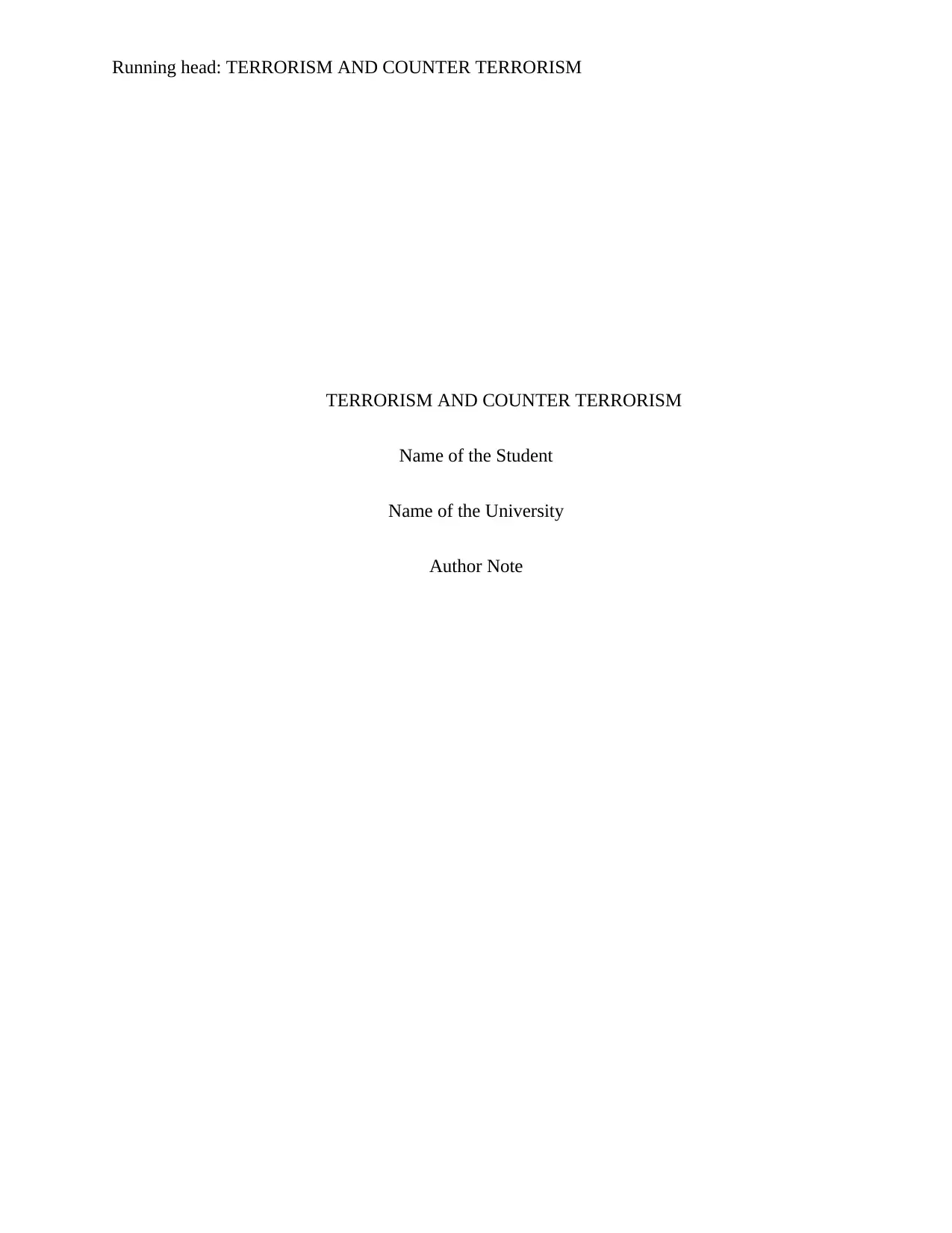
Running head: TERRORISM AND COUNTER TERRORISM
TERRORISM AND COUNTER TERRORISM
Name of the Student
Name of the University
Author Note
TERRORISM AND COUNTER TERRORISM
Name of the Student
Name of the University
Author Note
Paraphrase This Document
Need a fresh take? Get an instant paraphrase of this document with our AI Paraphraser
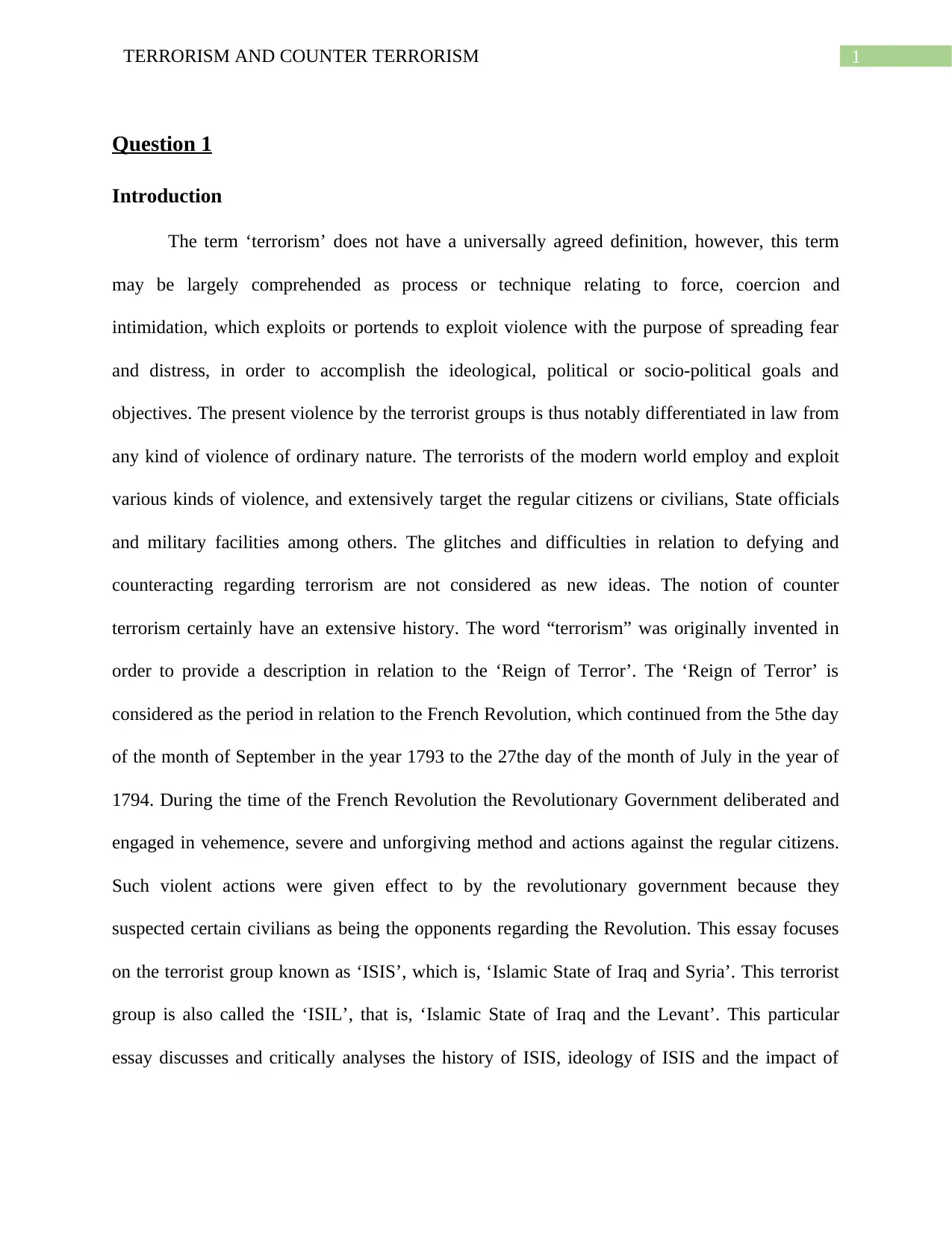
1TERRORISM AND COUNTER TERRORISM
Question 1
Introduction
The term ‘terrorism’ does not have a universally agreed definition, however, this term
may be largely comprehended as process or technique relating to force, coercion and
intimidation, which exploits or portends to exploit violence with the purpose of spreading fear
and distress, in order to accomplish the ideological, political or socio-political goals and
objectives. The present violence by the terrorist groups is thus notably differentiated in law from
any kind of violence of ordinary nature. The terrorists of the modern world employ and exploit
various kinds of violence, and extensively target the regular citizens or civilians, State officials
and military facilities among others. The glitches and difficulties in relation to defying and
counteracting regarding terrorism are not considered as new ideas. The notion of counter
terrorism certainly have an extensive history. The word “terrorism” was originally invented in
order to provide a description in relation to the ‘Reign of Terror’. The ‘Reign of Terror’ is
considered as the period in relation to the French Revolution, which continued from the 5the day
of the month of September in the year 1793 to the 27the day of the month of July in the year of
1794. During the time of the French Revolution the Revolutionary Government deliberated and
engaged in vehemence, severe and unforgiving method and actions against the regular citizens.
Such violent actions were given effect to by the revolutionary government because they
suspected certain civilians as being the opponents regarding the Revolution. This essay focuses
on the terrorist group known as ‘ISIS’, which is, ‘Islamic State of Iraq and Syria’. This terrorist
group is also called the ‘ISIL’, that is, ‘Islamic State of Iraq and the Levant’. This particular
essay discusses and critically analyses the history of ISIS, ideology of ISIS and the impact of
Question 1
Introduction
The term ‘terrorism’ does not have a universally agreed definition, however, this term
may be largely comprehended as process or technique relating to force, coercion and
intimidation, which exploits or portends to exploit violence with the purpose of spreading fear
and distress, in order to accomplish the ideological, political or socio-political goals and
objectives. The present violence by the terrorist groups is thus notably differentiated in law from
any kind of violence of ordinary nature. The terrorists of the modern world employ and exploit
various kinds of violence, and extensively target the regular citizens or civilians, State officials
and military facilities among others. The glitches and difficulties in relation to defying and
counteracting regarding terrorism are not considered as new ideas. The notion of counter
terrorism certainly have an extensive history. The word “terrorism” was originally invented in
order to provide a description in relation to the ‘Reign of Terror’. The ‘Reign of Terror’ is
considered as the period in relation to the French Revolution, which continued from the 5the day
of the month of September in the year 1793 to the 27the day of the month of July in the year of
1794. During the time of the French Revolution the Revolutionary Government deliberated and
engaged in vehemence, severe and unforgiving method and actions against the regular citizens.
Such violent actions were given effect to by the revolutionary government because they
suspected certain civilians as being the opponents regarding the Revolution. This essay focuses
on the terrorist group known as ‘ISIS’, which is, ‘Islamic State of Iraq and Syria’. This terrorist
group is also called the ‘ISIL’, that is, ‘Islamic State of Iraq and the Levant’. This particular
essay discusses and critically analyses the history of ISIS, ideology of ISIS and the impact of
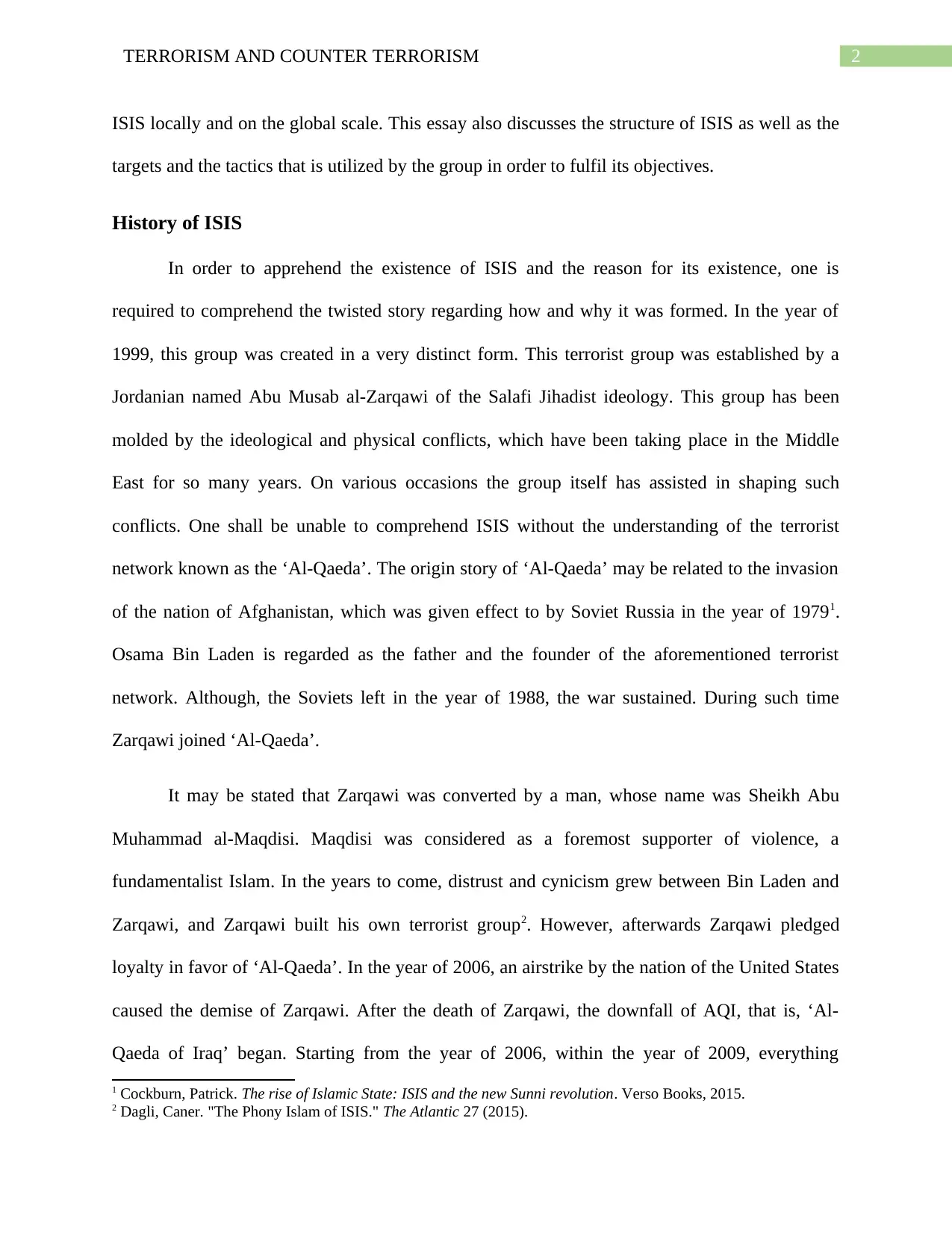
2TERRORISM AND COUNTER TERRORISM
ISIS locally and on the global scale. This essay also discusses the structure of ISIS as well as the
targets and the tactics that is utilized by the group in order to fulfil its objectives.
History of ISIS
In order to apprehend the existence of ISIS and the reason for its existence, one is
required to comprehend the twisted story regarding how and why it was formed. In the year of
1999, this group was created in a very distinct form. This terrorist group was established by a
Jordanian named Abu Musab al-Zarqawi of the Salafi Jihadist ideology. This group has been
molded by the ideological and physical conflicts, which have been taking place in the Middle
East for so many years. On various occasions the group itself has assisted in shaping such
conflicts. One shall be unable to comprehend ISIS without the understanding of the terrorist
network known as the ‘Al-Qaeda’. The origin story of ‘Al-Qaeda’ may be related to the invasion
of the nation of Afghanistan, which was given effect to by Soviet Russia in the year of 19791.
Osama Bin Laden is regarded as the father and the founder of the aforementioned terrorist
network. Although, the Soviets left in the year of 1988, the war sustained. During such time
Zarqawi joined ‘Al-Qaeda’.
It may be stated that Zarqawi was converted by a man, whose name was Sheikh Abu
Muhammad al-Maqdisi. Maqdisi was considered as a foremost supporter of violence, a
fundamentalist Islam. In the years to come, distrust and cynicism grew between Bin Laden and
Zarqawi, and Zarqawi built his own terrorist group2. However, afterwards Zarqawi pledged
loyalty in favor of ‘Al-Qaeda’. In the year of 2006, an airstrike by the nation of the United States
caused the demise of Zarqawi. After the death of Zarqawi, the downfall of AQI, that is, ‘Al-
Qaeda of Iraq’ began. Starting from the year of 2006, within the year of 2009, everything
1 Cockburn, Patrick. The rise of Islamic State: ISIS and the new Sunni revolution. Verso Books, 2015.
2 Dagli, Caner. "The Phony Islam of ISIS." The Atlantic 27 (2015).
ISIS locally and on the global scale. This essay also discusses the structure of ISIS as well as the
targets and the tactics that is utilized by the group in order to fulfil its objectives.
History of ISIS
In order to apprehend the existence of ISIS and the reason for its existence, one is
required to comprehend the twisted story regarding how and why it was formed. In the year of
1999, this group was created in a very distinct form. This terrorist group was established by a
Jordanian named Abu Musab al-Zarqawi of the Salafi Jihadist ideology. This group has been
molded by the ideological and physical conflicts, which have been taking place in the Middle
East for so many years. On various occasions the group itself has assisted in shaping such
conflicts. One shall be unable to comprehend ISIS without the understanding of the terrorist
network known as the ‘Al-Qaeda’. The origin story of ‘Al-Qaeda’ may be related to the invasion
of the nation of Afghanistan, which was given effect to by Soviet Russia in the year of 19791.
Osama Bin Laden is regarded as the father and the founder of the aforementioned terrorist
network. Although, the Soviets left in the year of 1988, the war sustained. During such time
Zarqawi joined ‘Al-Qaeda’.
It may be stated that Zarqawi was converted by a man, whose name was Sheikh Abu
Muhammad al-Maqdisi. Maqdisi was considered as a foremost supporter of violence, a
fundamentalist Islam. In the years to come, distrust and cynicism grew between Bin Laden and
Zarqawi, and Zarqawi built his own terrorist group2. However, afterwards Zarqawi pledged
loyalty in favor of ‘Al-Qaeda’. In the year of 2006, an airstrike by the nation of the United States
caused the demise of Zarqawi. After the death of Zarqawi, the downfall of AQI, that is, ‘Al-
Qaeda of Iraq’ began. Starting from the year of 2006, within the year of 2009, everything
1 Cockburn, Patrick. The rise of Islamic State: ISIS and the new Sunni revolution. Verso Books, 2015.
2 Dagli, Caner. "The Phony Islam of ISIS." The Atlantic 27 (2015).
⊘ This is a preview!⊘
Do you want full access?
Subscribe today to unlock all pages.

Trusted by 1+ million students worldwide
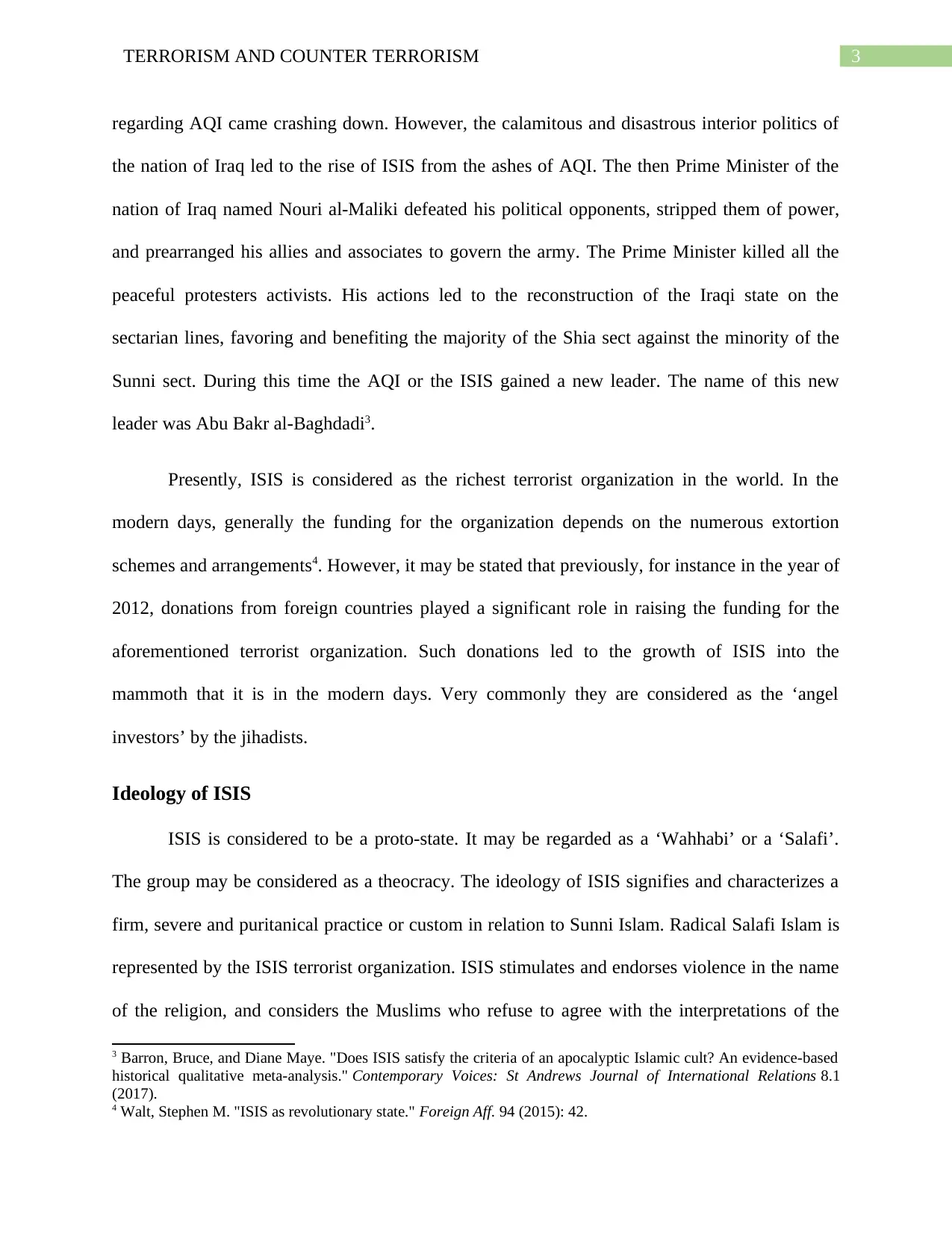
3TERRORISM AND COUNTER TERRORISM
regarding AQI came crashing down. However, the calamitous and disastrous interior politics of
the nation of Iraq led to the rise of ISIS from the ashes of AQI. The then Prime Minister of the
nation of Iraq named Nouri al-Maliki defeated his political opponents, stripped them of power,
and prearranged his allies and associates to govern the army. The Prime Minister killed all the
peaceful protesters activists. His actions led to the reconstruction of the Iraqi state on the
sectarian lines, favoring and benefiting the majority of the Shia sect against the minority of the
Sunni sect. During this time the AQI or the ISIS gained a new leader. The name of this new
leader was Abu Bakr al-Baghdadi3.
Presently, ISIS is considered as the richest terrorist organization in the world. In the
modern days, generally the funding for the organization depends on the numerous extortion
schemes and arrangements4. However, it may be stated that previously, for instance in the year of
2012, donations from foreign countries played a significant role in raising the funding for the
aforementioned terrorist organization. Such donations led to the growth of ISIS into the
mammoth that it is in the modern days. Very commonly they are considered as the ‘angel
investors’ by the jihadists.
Ideology of ISIS
ISIS is considered to be a proto-state. It may be regarded as a ‘Wahhabi’ or a ‘Salafi’.
The group may be considered as a theocracy. The ideology of ISIS signifies and characterizes a
firm, severe and puritanical practice or custom in relation to Sunni Islam. Radical Salafi Islam is
represented by the ISIS terrorist organization. ISIS stimulates and endorses violence in the name
of the religion, and considers the Muslims who refuse to agree with the interpretations of the
3 Barron, Bruce, and Diane Maye. "Does ISIS satisfy the criteria of an apocalyptic Islamic cult? An evidence-based
historical qualitative meta-analysis." Contemporary Voices: St Andrews Journal of International Relations 8.1
(2017).
4 Walt, Stephen M. "ISIS as revolutionary state." Foreign Aff. 94 (2015): 42.
regarding AQI came crashing down. However, the calamitous and disastrous interior politics of
the nation of Iraq led to the rise of ISIS from the ashes of AQI. The then Prime Minister of the
nation of Iraq named Nouri al-Maliki defeated his political opponents, stripped them of power,
and prearranged his allies and associates to govern the army. The Prime Minister killed all the
peaceful protesters activists. His actions led to the reconstruction of the Iraqi state on the
sectarian lines, favoring and benefiting the majority of the Shia sect against the minority of the
Sunni sect. During this time the AQI or the ISIS gained a new leader. The name of this new
leader was Abu Bakr al-Baghdadi3.
Presently, ISIS is considered as the richest terrorist organization in the world. In the
modern days, generally the funding for the organization depends on the numerous extortion
schemes and arrangements4. However, it may be stated that previously, for instance in the year of
2012, donations from foreign countries played a significant role in raising the funding for the
aforementioned terrorist organization. Such donations led to the growth of ISIS into the
mammoth that it is in the modern days. Very commonly they are considered as the ‘angel
investors’ by the jihadists.
Ideology of ISIS
ISIS is considered to be a proto-state. It may be regarded as a ‘Wahhabi’ or a ‘Salafi’.
The group may be considered as a theocracy. The ideology of ISIS signifies and characterizes a
firm, severe and puritanical practice or custom in relation to Sunni Islam. Radical Salafi Islam is
represented by the ISIS terrorist organization. ISIS stimulates and endorses violence in the name
of the religion, and considers the Muslims who refuse to agree with the interpretations of the
3 Barron, Bruce, and Diane Maye. "Does ISIS satisfy the criteria of an apocalyptic Islamic cult? An evidence-based
historical qualitative meta-analysis." Contemporary Voices: St Andrews Journal of International Relations 8.1
(2017).
4 Walt, Stephen M. "ISIS as revolutionary state." Foreign Aff. 94 (2015): 42.
Paraphrase This Document
Need a fresh take? Get an instant paraphrase of this document with our AI Paraphraser
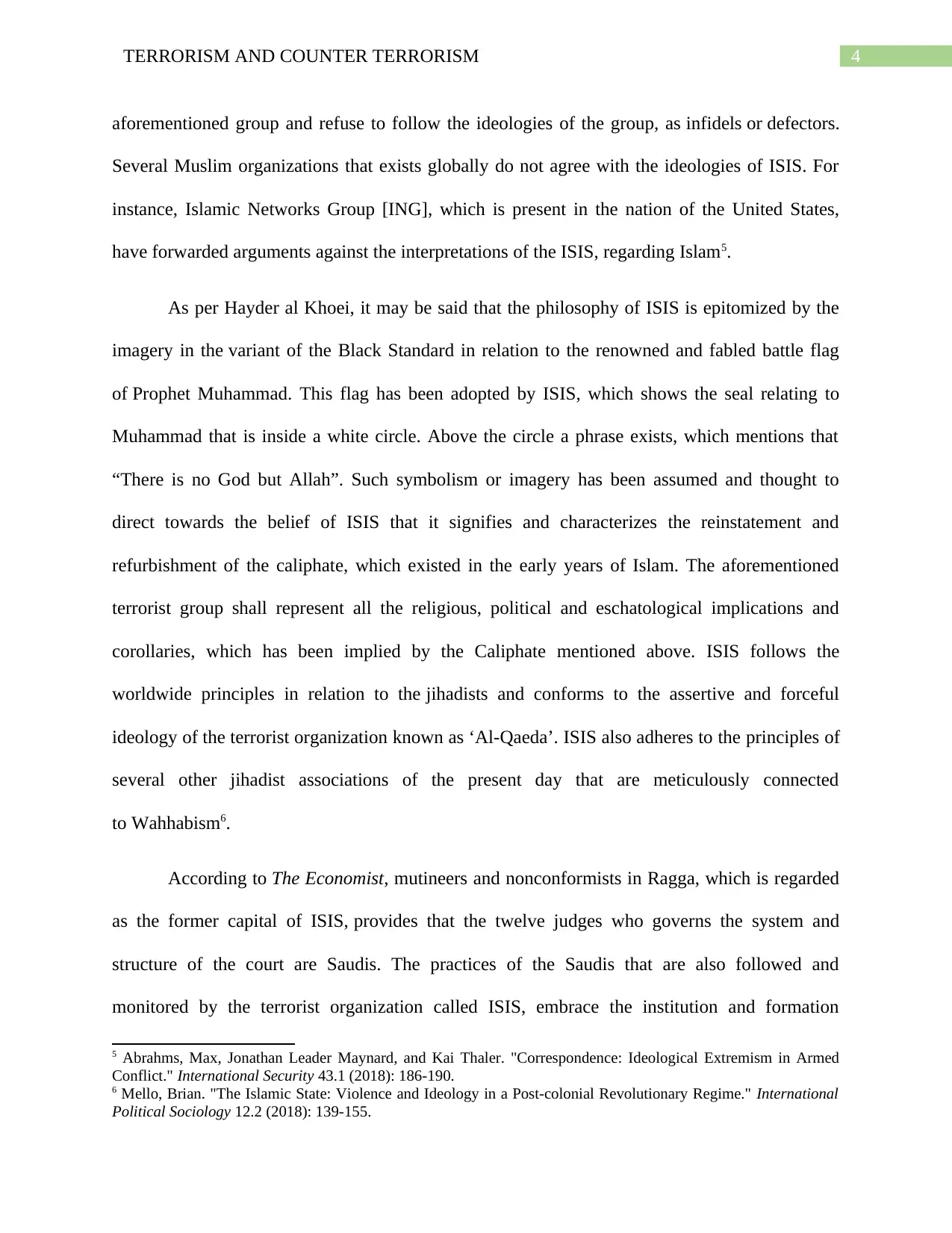
4TERRORISM AND COUNTER TERRORISM
aforementioned group and refuse to follow the ideologies of the group, as infidels or defectors.
Several Muslim organizations that exists globally do not agree with the ideologies of ISIS. For
instance, Islamic Networks Group [ING], which is present in the nation of the United States,
have forwarded arguments against the interpretations of the ISIS, regarding Islam5.
As per Hayder al Khoei, it may be said that the philosophy of ISIS is epitomized by the
imagery in the variant of the Black Standard in relation to the renowned and fabled battle flag
of Prophet Muhammad. This flag has been adopted by ISIS, which shows the seal relating to
Muhammad that is inside a white circle. Above the circle a phrase exists, which mentions that
“There is no God but Allah”. Such symbolism or imagery has been assumed and thought to
direct towards the belief of ISIS that it signifies and characterizes the reinstatement and
refurbishment of the caliphate, which existed in the early years of Islam. The aforementioned
terrorist group shall represent all the religious, political and eschatological implications and
corollaries, which has been implied by the Caliphate mentioned above. ISIS follows the
worldwide principles in relation to the jihadists and conforms to the assertive and forceful
ideology of the terrorist organization known as ‘Al-Qaeda’. ISIS also adheres to the principles of
several other jihadist associations of the present day that are meticulously connected
to Wahhabism6.
According to The Economist, mutineers and nonconformists in Ragga, which is regarded
as the former capital of ISIS, provides that the twelve judges who governs the system and
structure of the court are Saudis. The practices of the Saudis that are also followed and
monitored by the terrorist organization called ISIS, embrace the institution and formation
5 Abrahms, Max, Jonathan Leader Maynard, and Kai Thaler. "Correspondence: Ideological Extremism in Armed
Conflict." International Security 43.1 (2018): 186-190.
6 Mello, Brian. "The Islamic State: Violence and Ideology in a Post-colonial Revolutionary Regime." International
Political Sociology 12.2 (2018): 139-155.
aforementioned group and refuse to follow the ideologies of the group, as infidels or defectors.
Several Muslim organizations that exists globally do not agree with the ideologies of ISIS. For
instance, Islamic Networks Group [ING], which is present in the nation of the United States,
have forwarded arguments against the interpretations of the ISIS, regarding Islam5.
As per Hayder al Khoei, it may be said that the philosophy of ISIS is epitomized by the
imagery in the variant of the Black Standard in relation to the renowned and fabled battle flag
of Prophet Muhammad. This flag has been adopted by ISIS, which shows the seal relating to
Muhammad that is inside a white circle. Above the circle a phrase exists, which mentions that
“There is no God but Allah”. Such symbolism or imagery has been assumed and thought to
direct towards the belief of ISIS that it signifies and characterizes the reinstatement and
refurbishment of the caliphate, which existed in the early years of Islam. The aforementioned
terrorist group shall represent all the religious, political and eschatological implications and
corollaries, which has been implied by the Caliphate mentioned above. ISIS follows the
worldwide principles in relation to the jihadists and conforms to the assertive and forceful
ideology of the terrorist organization known as ‘Al-Qaeda’. ISIS also adheres to the principles of
several other jihadist associations of the present day that are meticulously connected
to Wahhabism6.
According to The Economist, mutineers and nonconformists in Ragga, which is regarded
as the former capital of ISIS, provides that the twelve judges who governs the system and
structure of the court are Saudis. The practices of the Saudis that are also followed and
monitored by the terrorist organization called ISIS, embrace the institution and formation
5 Abrahms, Max, Jonathan Leader Maynard, and Kai Thaler. "Correspondence: Ideological Extremism in Armed
Conflict." International Security 43.1 (2018): 186-190.
6 Mello, Brian. "The Islamic State: Violence and Ideology in a Post-colonial Revolutionary Regime." International
Political Sociology 12.2 (2018): 139-155.
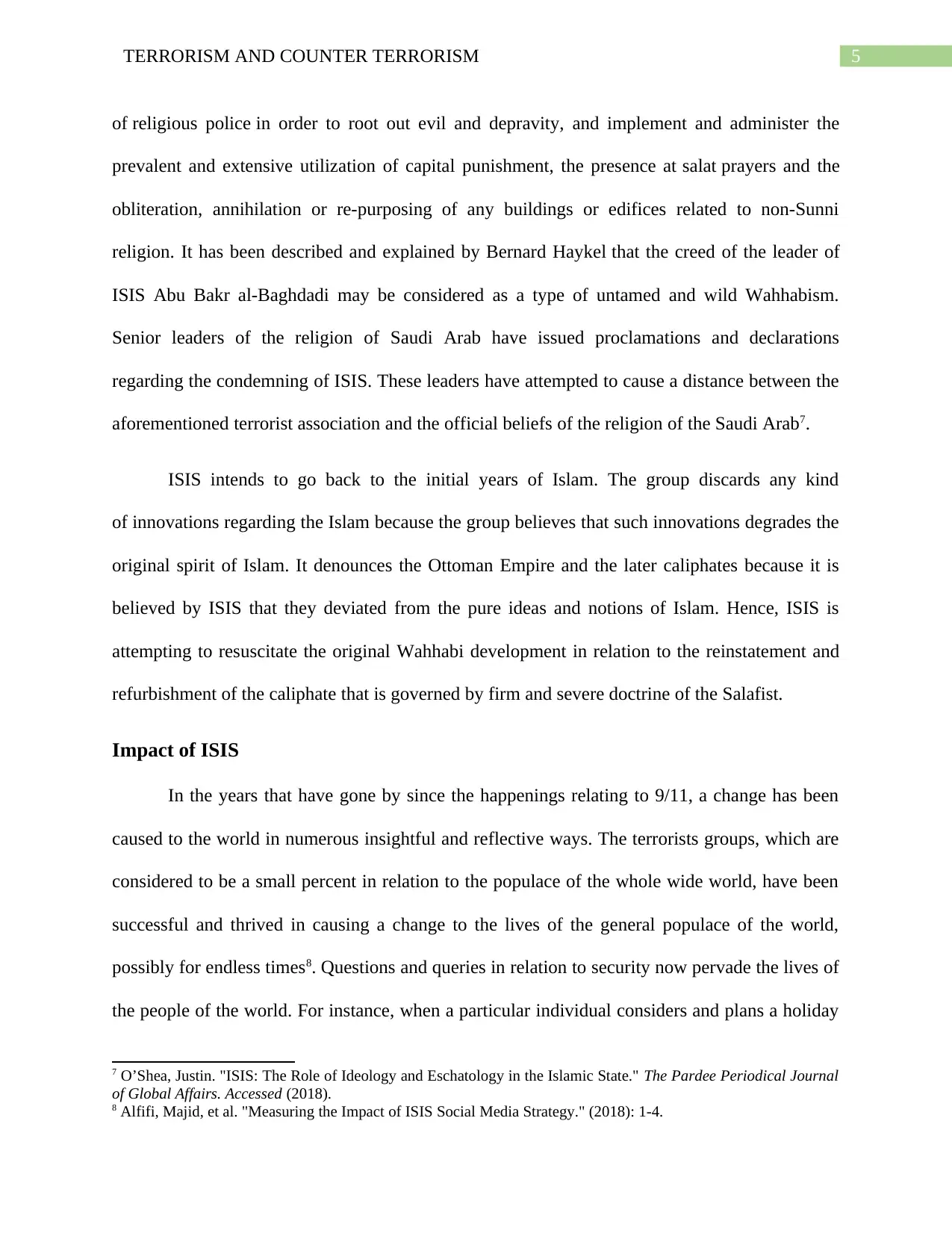
5TERRORISM AND COUNTER TERRORISM
of religious police in order to root out evil and depravity, and implement and administer the
prevalent and extensive utilization of capital punishment, the presence at salat prayers and the
obliteration, annihilation or re-purposing of any buildings or edifices related to non-Sunni
religion. It has been described and explained by Bernard Haykel that the creed of the leader of
ISIS Abu Bakr al-Baghdadi may be considered as a type of untamed and wild Wahhabism.
Senior leaders of the religion of Saudi Arab have issued proclamations and declarations
regarding the condemning of ISIS. These leaders have attempted to cause a distance between the
aforementioned terrorist association and the official beliefs of the religion of the Saudi Arab7.
ISIS intends to go back to the initial years of Islam. The group discards any kind
of innovations regarding the Islam because the group believes that such innovations degrades the
original spirit of Islam. It denounces the Ottoman Empire and the later caliphates because it is
believed by ISIS that they deviated from the pure ideas and notions of Islam. Hence, ISIS is
attempting to resuscitate the original Wahhabi development in relation to the reinstatement and
refurbishment of the caliphate that is governed by firm and severe doctrine of the Salafist.
Impact of ISIS
In the years that have gone by since the happenings relating to 9/11, a change has been
caused to the world in numerous insightful and reflective ways. The terrorists groups, which are
considered to be a small percent in relation to the populace of the whole wide world, have been
successful and thrived in causing a change to the lives of the general populace of the world,
possibly for endless times8. Questions and queries in relation to security now pervade the lives of
the people of the world. For instance, when a particular individual considers and plans a holiday
7 O’Shea, Justin. "ISIS: The Role of Ideology and Eschatology in the Islamic State." The Pardee Periodical Journal
of Global Affairs. Accessed (2018).
8 Alfifi, Majid, et al. "Measuring the Impact of ISIS Social Media Strategy." (2018): 1-4.
of religious police in order to root out evil and depravity, and implement and administer the
prevalent and extensive utilization of capital punishment, the presence at salat prayers and the
obliteration, annihilation or re-purposing of any buildings or edifices related to non-Sunni
religion. It has been described and explained by Bernard Haykel that the creed of the leader of
ISIS Abu Bakr al-Baghdadi may be considered as a type of untamed and wild Wahhabism.
Senior leaders of the religion of Saudi Arab have issued proclamations and declarations
regarding the condemning of ISIS. These leaders have attempted to cause a distance between the
aforementioned terrorist association and the official beliefs of the religion of the Saudi Arab7.
ISIS intends to go back to the initial years of Islam. The group discards any kind
of innovations regarding the Islam because the group believes that such innovations degrades the
original spirit of Islam. It denounces the Ottoman Empire and the later caliphates because it is
believed by ISIS that they deviated from the pure ideas and notions of Islam. Hence, ISIS is
attempting to resuscitate the original Wahhabi development in relation to the reinstatement and
refurbishment of the caliphate that is governed by firm and severe doctrine of the Salafist.
Impact of ISIS
In the years that have gone by since the happenings relating to 9/11, a change has been
caused to the world in numerous insightful and reflective ways. The terrorists groups, which are
considered to be a small percent in relation to the populace of the whole wide world, have been
successful and thrived in causing a change to the lives of the general populace of the world,
possibly for endless times8. Questions and queries in relation to security now pervade the lives of
the people of the world. For instance, when a particular individual considers and plans a holiday
7 O’Shea, Justin. "ISIS: The Role of Ideology and Eschatology in the Islamic State." The Pardee Periodical Journal
of Global Affairs. Accessed (2018).
8 Alfifi, Majid, et al. "Measuring the Impact of ISIS Social Media Strategy." (2018): 1-4.
⊘ This is a preview!⊘
Do you want full access?
Subscribe today to unlock all pages.

Trusted by 1+ million students worldwide
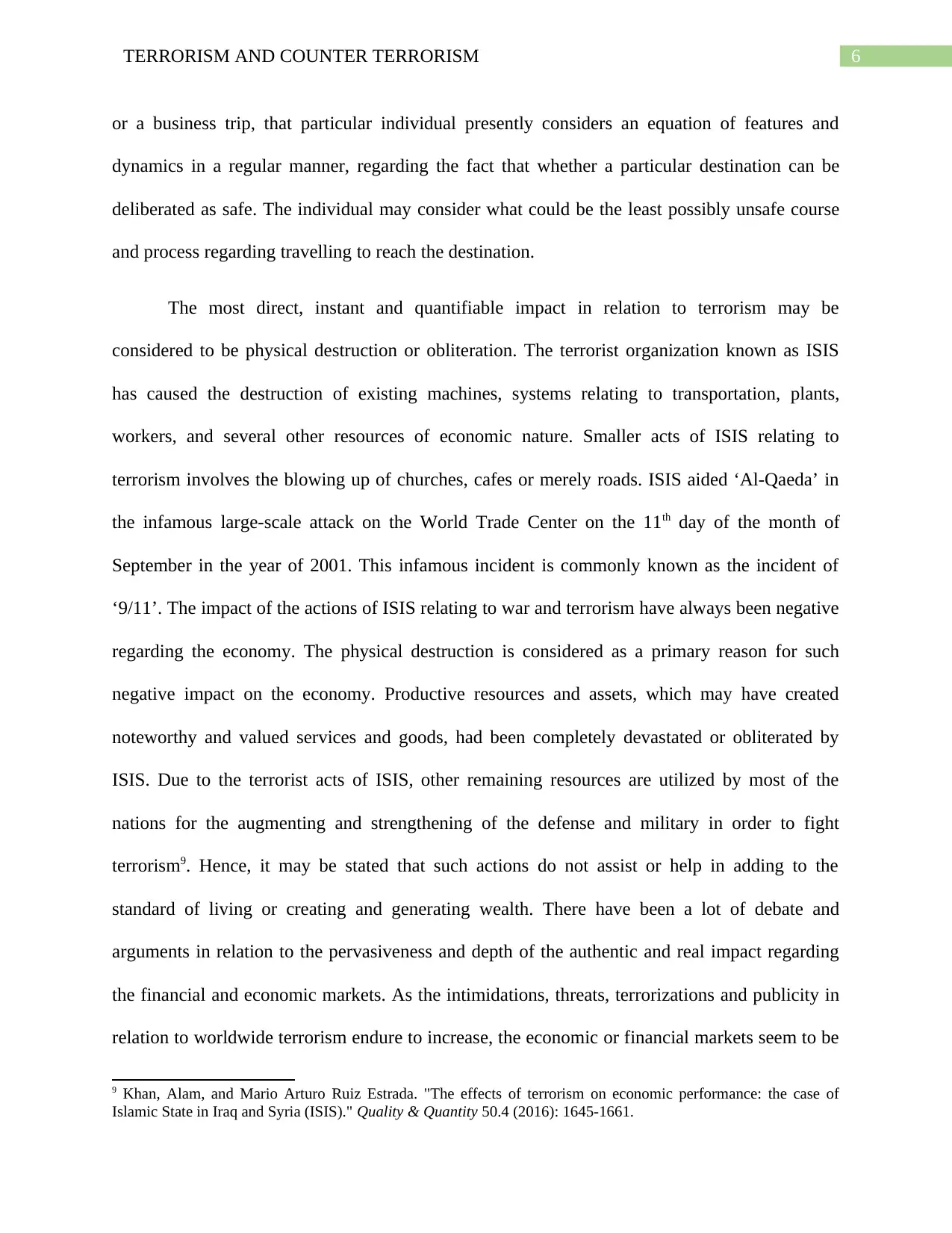
6TERRORISM AND COUNTER TERRORISM
or a business trip, that particular individual presently considers an equation of features and
dynamics in a regular manner, regarding the fact that whether a particular destination can be
deliberated as safe. The individual may consider what could be the least possibly unsafe course
and process regarding travelling to reach the destination.
The most direct, instant and quantifiable impact in relation to terrorism may be
considered to be physical destruction or obliteration. The terrorist organization known as ISIS
has caused the destruction of existing machines, systems relating to transportation, plants,
workers, and several other resources of economic nature. Smaller acts of ISIS relating to
terrorism involves the blowing up of churches, cafes or merely roads. ISIS aided ‘Al-Qaeda’ in
the infamous large-scale attack on the World Trade Center on the 11th day of the month of
September in the year of 2001. This infamous incident is commonly known as the incident of
‘9/11’. The impact of the actions of ISIS relating to war and terrorism have always been negative
regarding the economy. The physical destruction is considered as a primary reason for such
negative impact on the economy. Productive resources and assets, which may have created
noteworthy and valued services and goods, had been completely devastated or obliterated by
ISIS. Due to the terrorist acts of ISIS, other remaining resources are utilized by most of the
nations for the augmenting and strengthening of the defense and military in order to fight
terrorism9. Hence, it may be stated that such actions do not assist or help in adding to the
standard of living or creating and generating wealth. There have been a lot of debate and
arguments in relation to the pervasiveness and depth of the authentic and real impact regarding
the financial and economic markets. As the intimidations, threats, terrorizations and publicity in
relation to worldwide terrorism endure to increase, the economic or financial markets seem to be
9 Khan, Alam, and Mario Arturo Ruiz Estrada. "The effects of terrorism on economic performance: the case of
Islamic State in Iraq and Syria (ISIS)." Quality & Quantity 50.4 (2016): 1645-1661.
or a business trip, that particular individual presently considers an equation of features and
dynamics in a regular manner, regarding the fact that whether a particular destination can be
deliberated as safe. The individual may consider what could be the least possibly unsafe course
and process regarding travelling to reach the destination.
The most direct, instant and quantifiable impact in relation to terrorism may be
considered to be physical destruction or obliteration. The terrorist organization known as ISIS
has caused the destruction of existing machines, systems relating to transportation, plants,
workers, and several other resources of economic nature. Smaller acts of ISIS relating to
terrorism involves the blowing up of churches, cafes or merely roads. ISIS aided ‘Al-Qaeda’ in
the infamous large-scale attack on the World Trade Center on the 11th day of the month of
September in the year of 2001. This infamous incident is commonly known as the incident of
‘9/11’. The impact of the actions of ISIS relating to war and terrorism have always been negative
regarding the economy. The physical destruction is considered as a primary reason for such
negative impact on the economy. Productive resources and assets, which may have created
noteworthy and valued services and goods, had been completely devastated or obliterated by
ISIS. Due to the terrorist acts of ISIS, other remaining resources are utilized by most of the
nations for the augmenting and strengthening of the defense and military in order to fight
terrorism9. Hence, it may be stated that such actions do not assist or help in adding to the
standard of living or creating and generating wealth. There have been a lot of debate and
arguments in relation to the pervasiveness and depth of the authentic and real impact regarding
the financial and economic markets. As the intimidations, threats, terrorizations and publicity in
relation to worldwide terrorism endure to increase, the economic or financial markets seem to be
9 Khan, Alam, and Mario Arturo Ruiz Estrada. "The effects of terrorism on economic performance: the case of
Islamic State in Iraq and Syria (ISIS)." Quality & Quantity 50.4 (2016): 1645-1661.
Paraphrase This Document
Need a fresh take? Get an instant paraphrase of this document with our AI Paraphraser
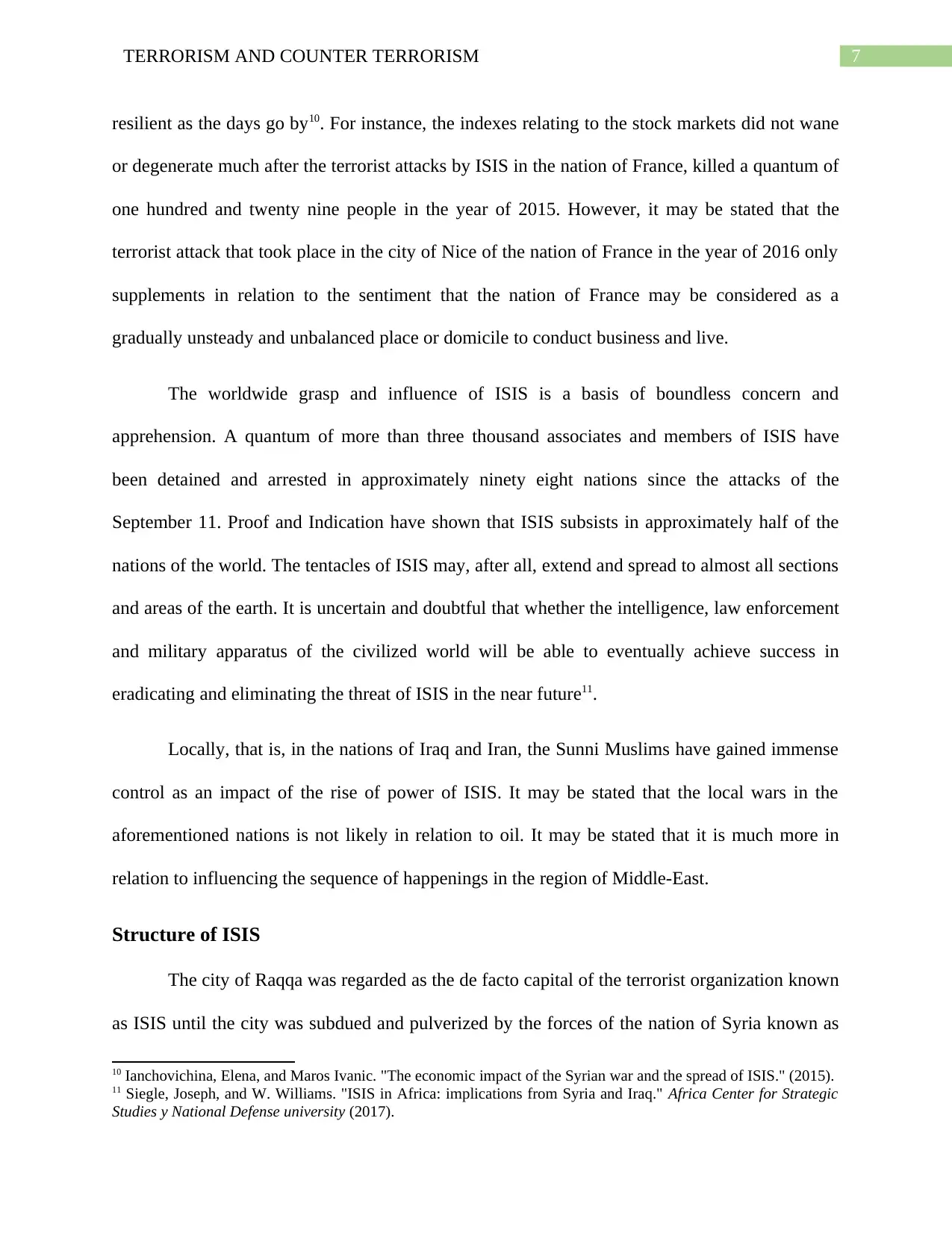
7TERRORISM AND COUNTER TERRORISM
resilient as the days go by10. For instance, the indexes relating to the stock markets did not wane
or degenerate much after the terrorist attacks by ISIS in the nation of France, killed a quantum of
one hundred and twenty nine people in the year of 2015. However, it may be stated that the
terrorist attack that took place in the city of Nice of the nation of France in the year of 2016 only
supplements in relation to the sentiment that the nation of France may be considered as a
gradually unsteady and unbalanced place or domicile to conduct business and live.
The worldwide grasp and influence of ISIS is a basis of boundless concern and
apprehension. A quantum of more than three thousand associates and members of ISIS have
been detained and arrested in approximately ninety eight nations since the attacks of the
September 11. Proof and Indication have shown that ISIS subsists in approximately half of the
nations of the world. The tentacles of ISIS may, after all, extend and spread to almost all sections
and areas of the earth. It is uncertain and doubtful that whether the intelligence, law enforcement
and military apparatus of the civilized world will be able to eventually achieve success in
eradicating and eliminating the threat of ISIS in the near future11.
Locally, that is, in the nations of Iraq and Iran, the Sunni Muslims have gained immense
control as an impact of the rise of power of ISIS. It may be stated that the local wars in the
aforementioned nations is not likely in relation to oil. It may be stated that it is much more in
relation to influencing the sequence of happenings in the region of Middle-East.
Structure of ISIS
The city of Raqqa was regarded as the de facto capital of the terrorist organization known
as ISIS until the city was subdued and pulverized by the forces of the nation of Syria known as
10 Ianchovichina, Elena, and Maros Ivanic. "The economic impact of the Syrian war and the spread of ISIS." (2015).
11 Siegle, Joseph, and W. Williams. "ISIS in Africa: implications from Syria and Iraq." Africa Center for Strategic
Studies y National Defense university (2017).
resilient as the days go by10. For instance, the indexes relating to the stock markets did not wane
or degenerate much after the terrorist attacks by ISIS in the nation of France, killed a quantum of
one hundred and twenty nine people in the year of 2015. However, it may be stated that the
terrorist attack that took place in the city of Nice of the nation of France in the year of 2016 only
supplements in relation to the sentiment that the nation of France may be considered as a
gradually unsteady and unbalanced place or domicile to conduct business and live.
The worldwide grasp and influence of ISIS is a basis of boundless concern and
apprehension. A quantum of more than three thousand associates and members of ISIS have
been detained and arrested in approximately ninety eight nations since the attacks of the
September 11. Proof and Indication have shown that ISIS subsists in approximately half of the
nations of the world. The tentacles of ISIS may, after all, extend and spread to almost all sections
and areas of the earth. It is uncertain and doubtful that whether the intelligence, law enforcement
and military apparatus of the civilized world will be able to eventually achieve success in
eradicating and eliminating the threat of ISIS in the near future11.
Locally, that is, in the nations of Iraq and Iran, the Sunni Muslims have gained immense
control as an impact of the rise of power of ISIS. It may be stated that the local wars in the
aforementioned nations is not likely in relation to oil. It may be stated that it is much more in
relation to influencing the sequence of happenings in the region of Middle-East.
Structure of ISIS
The city of Raqqa was regarded as the de facto capital of the terrorist organization known
as ISIS until the city was subdued and pulverized by the forces of the nation of Syria known as
10 Ianchovichina, Elena, and Maros Ivanic. "The economic impact of the Syrian war and the spread of ISIS." (2015).
11 Siegle, Joseph, and W. Williams. "ISIS in Africa: implications from Syria and Iraq." Africa Center for Strategic
Studies y National Defense university (2017).
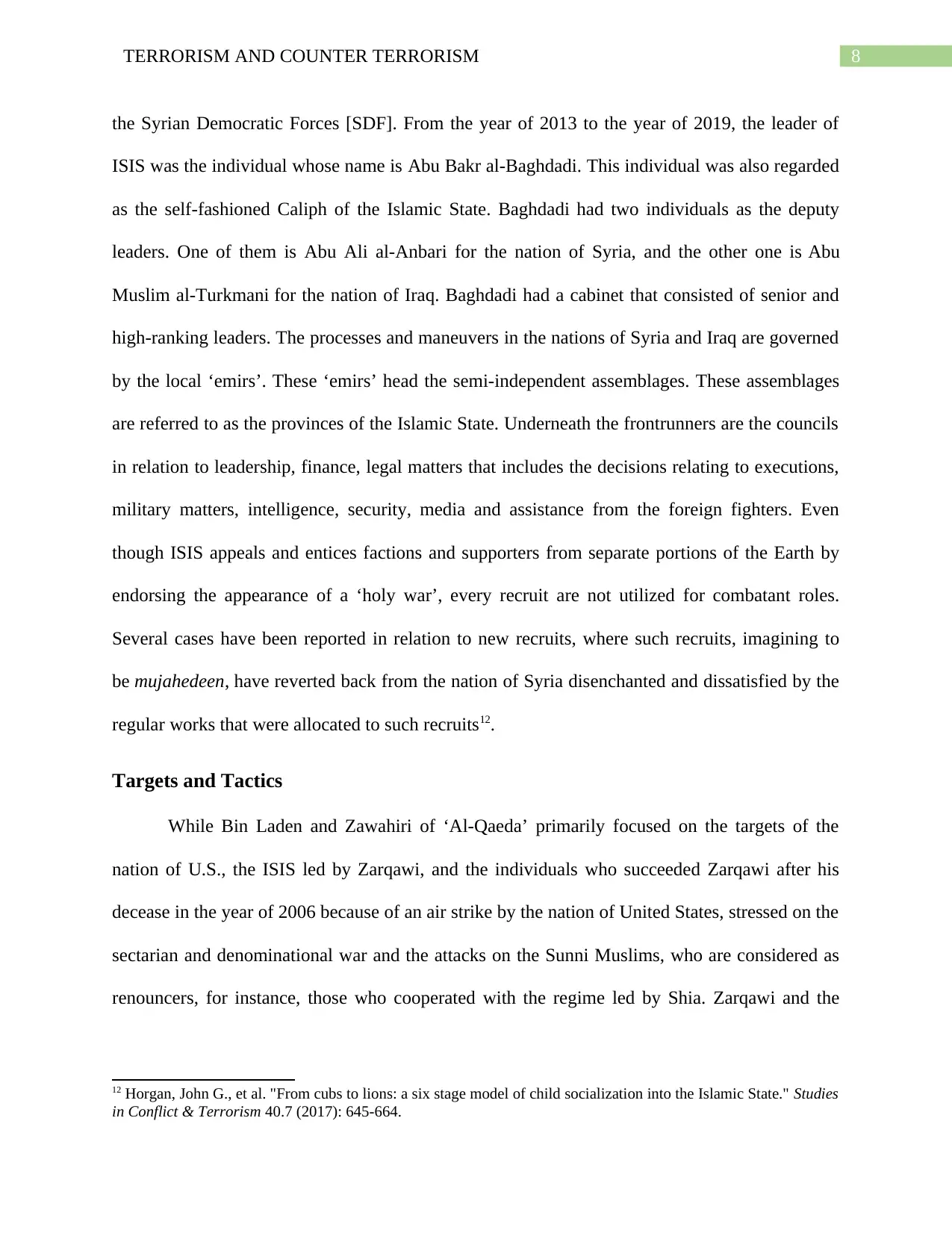
8TERRORISM AND COUNTER TERRORISM
the Syrian Democratic Forces [SDF]. From the year of 2013 to the year of 2019, the leader of
ISIS was the individual whose name is Abu Bakr al-Baghdadi. This individual was also regarded
as the self-fashioned Caliph of the Islamic State. Baghdadi had two individuals as the deputy
leaders. One of them is Abu Ali al-Anbari for the nation of Syria, and the other one is Abu
Muslim al-Turkmani for the nation of Iraq. Baghdadi had a cabinet that consisted of senior and
high-ranking leaders. The processes and maneuvers in the nations of Syria and Iraq are governed
by the local ‘emirs’. These ‘emirs’ head the semi-independent assemblages. These assemblages
are referred to as the provinces of the Islamic State. Underneath the frontrunners are the councils
in relation to leadership, finance, legal matters that includes the decisions relating to executions,
military matters, intelligence, security, media and assistance from the foreign fighters. Even
though ISIS appeals and entices factions and supporters from separate portions of the Earth by
endorsing the appearance of a ‘holy war’, every recruit are not utilized for combatant roles.
Several cases have been reported in relation to new recruits, where such recruits, imagining to
be mujahedeen, have reverted back from the nation of Syria disenchanted and dissatisfied by the
regular works that were allocated to such recruits12.
Targets and Tactics
While Bin Laden and Zawahiri of ‘Al-Qaeda’ primarily focused on the targets of the
nation of U.S., the ISIS led by Zarqawi, and the individuals who succeeded Zarqawi after his
decease in the year of 2006 because of an air strike by the nation of United States, stressed on the
sectarian and denominational war and the attacks on the Sunni Muslims, who are considered as
renouncers, for instance, those who cooperated with the regime led by Shia. Zarqawi and the
12 Horgan, John G., et al. "From cubs to lions: a six stage model of child socialization into the Islamic State." Studies
in Conflict & Terrorism 40.7 (2017): 645-664.
the Syrian Democratic Forces [SDF]. From the year of 2013 to the year of 2019, the leader of
ISIS was the individual whose name is Abu Bakr al-Baghdadi. This individual was also regarded
as the self-fashioned Caliph of the Islamic State. Baghdadi had two individuals as the deputy
leaders. One of them is Abu Ali al-Anbari for the nation of Syria, and the other one is Abu
Muslim al-Turkmani for the nation of Iraq. Baghdadi had a cabinet that consisted of senior and
high-ranking leaders. The processes and maneuvers in the nations of Syria and Iraq are governed
by the local ‘emirs’. These ‘emirs’ head the semi-independent assemblages. These assemblages
are referred to as the provinces of the Islamic State. Underneath the frontrunners are the councils
in relation to leadership, finance, legal matters that includes the decisions relating to executions,
military matters, intelligence, security, media and assistance from the foreign fighters. Even
though ISIS appeals and entices factions and supporters from separate portions of the Earth by
endorsing the appearance of a ‘holy war’, every recruit are not utilized for combatant roles.
Several cases have been reported in relation to new recruits, where such recruits, imagining to
be mujahedeen, have reverted back from the nation of Syria disenchanted and dissatisfied by the
regular works that were allocated to such recruits12.
Targets and Tactics
While Bin Laden and Zawahiri of ‘Al-Qaeda’ primarily focused on the targets of the
nation of U.S., the ISIS led by Zarqawi, and the individuals who succeeded Zarqawi after his
decease in the year of 2006 because of an air strike by the nation of United States, stressed on the
sectarian and denominational war and the attacks on the Sunni Muslims, who are considered as
renouncers, for instance, those who cooperated with the regime led by Shia. Zarqawi and the
12 Horgan, John G., et al. "From cubs to lions: a six stage model of child socialization into the Islamic State." Studies
in Conflict & Terrorism 40.7 (2017): 645-664.
⊘ This is a preview!⊘
Do you want full access?
Subscribe today to unlock all pages.

Trusted by 1+ million students worldwide
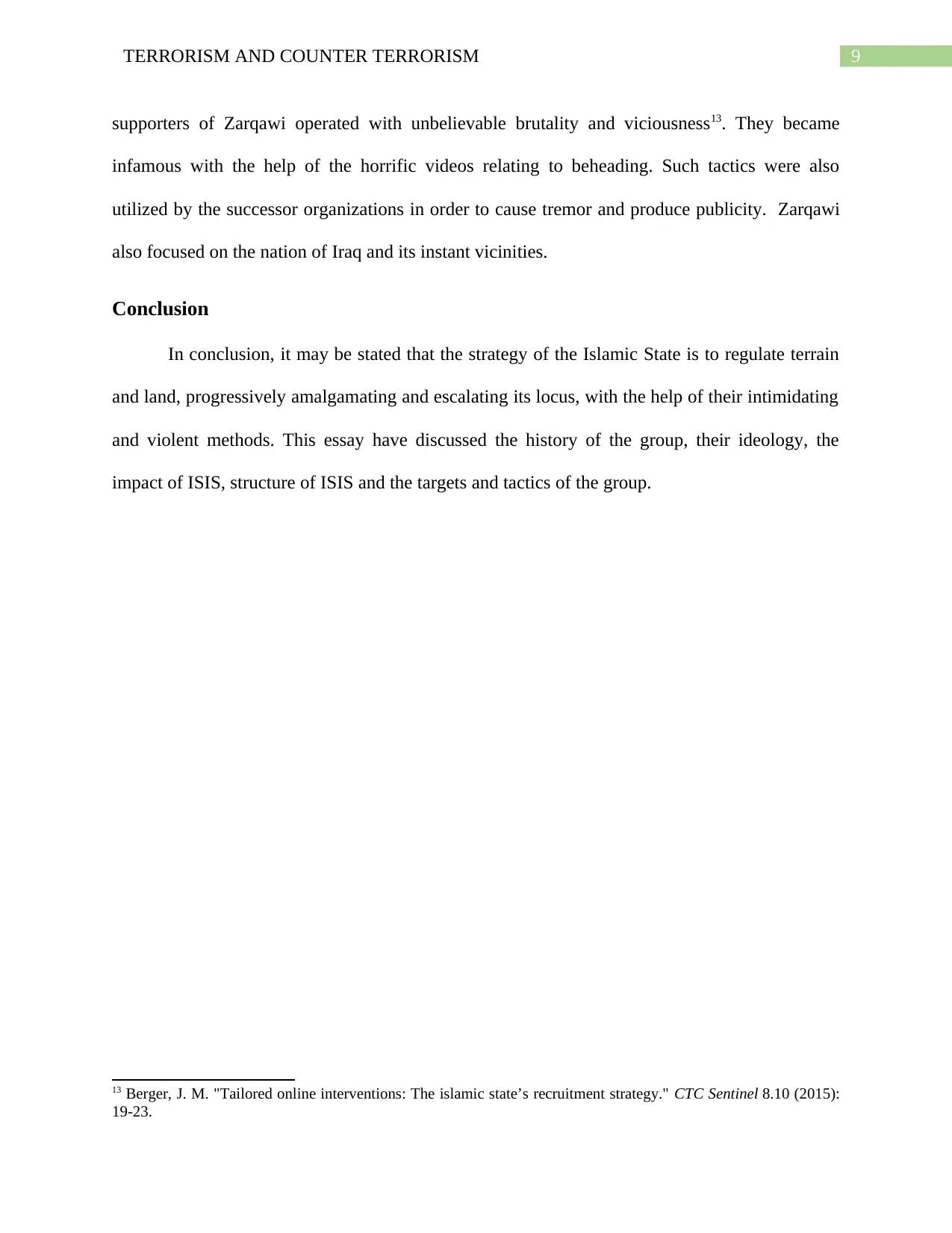
9TERRORISM AND COUNTER TERRORISM
supporters of Zarqawi operated with unbelievable brutality and viciousness13. They became
infamous with the help of the horrific videos relating to beheading. Such tactics were also
utilized by the successor organizations in order to cause tremor and produce publicity. Zarqawi
also focused on the nation of Iraq and its instant vicinities.
Conclusion
In conclusion, it may be stated that the strategy of the Islamic State is to regulate terrain
and land, progressively amalgamating and escalating its locus, with the help of their intimidating
and violent methods. This essay have discussed the history of the group, their ideology, the
impact of ISIS, structure of ISIS and the targets and tactics of the group.
13 Berger, J. M. "Tailored online interventions: The islamic state’s recruitment strategy." CTC Sentinel 8.10 (2015):
19-23.
supporters of Zarqawi operated with unbelievable brutality and viciousness13. They became
infamous with the help of the horrific videos relating to beheading. Such tactics were also
utilized by the successor organizations in order to cause tremor and produce publicity. Zarqawi
also focused on the nation of Iraq and its instant vicinities.
Conclusion
In conclusion, it may be stated that the strategy of the Islamic State is to regulate terrain
and land, progressively amalgamating and escalating its locus, with the help of their intimidating
and violent methods. This essay have discussed the history of the group, their ideology, the
impact of ISIS, structure of ISIS and the targets and tactics of the group.
13 Berger, J. M. "Tailored online interventions: The islamic state’s recruitment strategy." CTC Sentinel 8.10 (2015):
19-23.
Paraphrase This Document
Need a fresh take? Get an instant paraphrase of this document with our AI Paraphraser
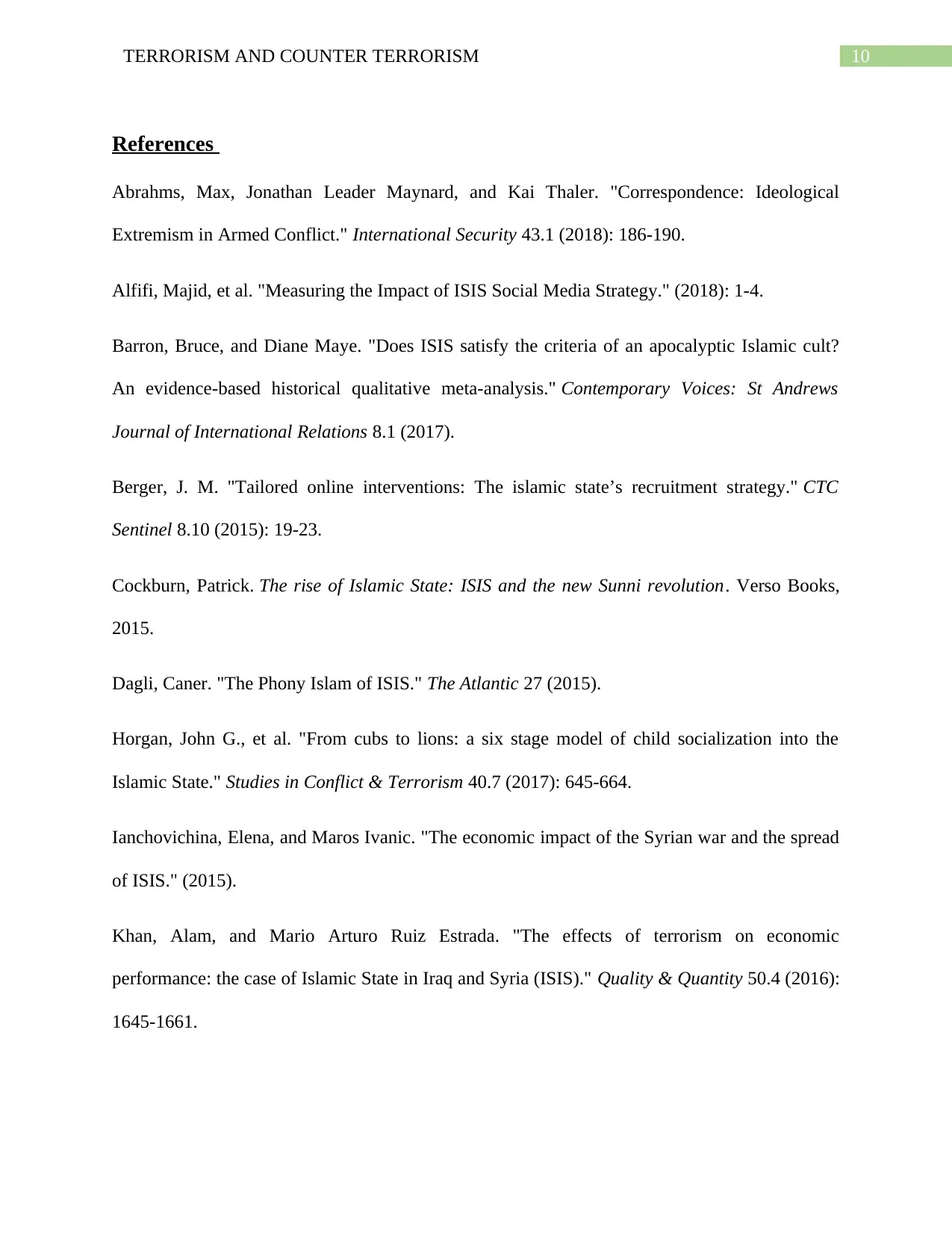
10TERRORISM AND COUNTER TERRORISM
References
Abrahms, Max, Jonathan Leader Maynard, and Kai Thaler. "Correspondence: Ideological
Extremism in Armed Conflict." International Security 43.1 (2018): 186-190.
Alfifi, Majid, et al. "Measuring the Impact of ISIS Social Media Strategy." (2018): 1-4.
Barron, Bruce, and Diane Maye. "Does ISIS satisfy the criteria of an apocalyptic Islamic cult?
An evidence-based historical qualitative meta-analysis." Contemporary Voices: St Andrews
Journal of International Relations 8.1 (2017).
Berger, J. M. "Tailored online interventions: The islamic state’s recruitment strategy." CTC
Sentinel 8.10 (2015): 19-23.
Cockburn, Patrick. The rise of Islamic State: ISIS and the new Sunni revolution. Verso Books,
2015.
Dagli, Caner. "The Phony Islam of ISIS." The Atlantic 27 (2015).
Horgan, John G., et al. "From cubs to lions: a six stage model of child socialization into the
Islamic State." Studies in Conflict & Terrorism 40.7 (2017): 645-664.
Ianchovichina, Elena, and Maros Ivanic. "The economic impact of the Syrian war and the spread
of ISIS." (2015).
Khan, Alam, and Mario Arturo Ruiz Estrada. "The effects of terrorism on economic
performance: the case of Islamic State in Iraq and Syria (ISIS)." Quality & Quantity 50.4 (2016):
1645-1661.
References
Abrahms, Max, Jonathan Leader Maynard, and Kai Thaler. "Correspondence: Ideological
Extremism in Armed Conflict." International Security 43.1 (2018): 186-190.
Alfifi, Majid, et al. "Measuring the Impact of ISIS Social Media Strategy." (2018): 1-4.
Barron, Bruce, and Diane Maye. "Does ISIS satisfy the criteria of an apocalyptic Islamic cult?
An evidence-based historical qualitative meta-analysis." Contemporary Voices: St Andrews
Journal of International Relations 8.1 (2017).
Berger, J. M. "Tailored online interventions: The islamic state’s recruitment strategy." CTC
Sentinel 8.10 (2015): 19-23.
Cockburn, Patrick. The rise of Islamic State: ISIS and the new Sunni revolution. Verso Books,
2015.
Dagli, Caner. "The Phony Islam of ISIS." The Atlantic 27 (2015).
Horgan, John G., et al. "From cubs to lions: a six stage model of child socialization into the
Islamic State." Studies in Conflict & Terrorism 40.7 (2017): 645-664.
Ianchovichina, Elena, and Maros Ivanic. "The economic impact of the Syrian war and the spread
of ISIS." (2015).
Khan, Alam, and Mario Arturo Ruiz Estrada. "The effects of terrorism on economic
performance: the case of Islamic State in Iraq and Syria (ISIS)." Quality & Quantity 50.4 (2016):
1645-1661.
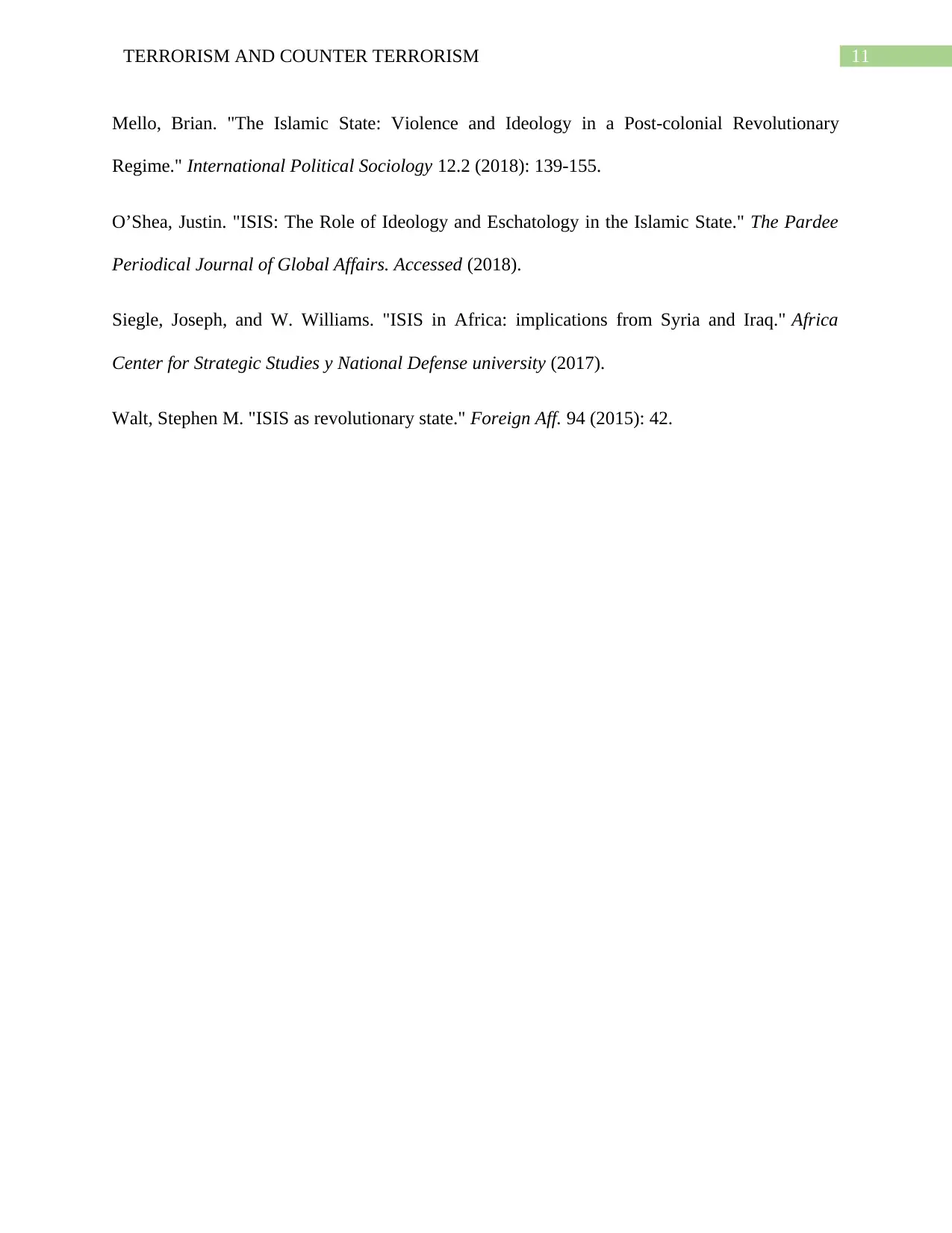
11TERRORISM AND COUNTER TERRORISM
Mello, Brian. "The Islamic State: Violence and Ideology in a Post-colonial Revolutionary
Regime." International Political Sociology 12.2 (2018): 139-155.
O’Shea, Justin. "ISIS: The Role of Ideology and Eschatology in the Islamic State." The Pardee
Periodical Journal of Global Affairs. Accessed (2018).
Siegle, Joseph, and W. Williams. "ISIS in Africa: implications from Syria and Iraq." Africa
Center for Strategic Studies y National Defense university (2017).
Walt, Stephen M. "ISIS as revolutionary state." Foreign Aff. 94 (2015): 42.
Mello, Brian. "The Islamic State: Violence and Ideology in a Post-colonial Revolutionary
Regime." International Political Sociology 12.2 (2018): 139-155.
O’Shea, Justin. "ISIS: The Role of Ideology and Eschatology in the Islamic State." The Pardee
Periodical Journal of Global Affairs. Accessed (2018).
Siegle, Joseph, and W. Williams. "ISIS in Africa: implications from Syria and Iraq." Africa
Center for Strategic Studies y National Defense university (2017).
Walt, Stephen M. "ISIS as revolutionary state." Foreign Aff. 94 (2015): 42.
⊘ This is a preview!⊘
Do you want full access?
Subscribe today to unlock all pages.

Trusted by 1+ million students worldwide
1 out of 22
Your All-in-One AI-Powered Toolkit for Academic Success.
+13062052269
info@desklib.com
Available 24*7 on WhatsApp / Email
![[object Object]](/_next/static/media/star-bottom.7253800d.svg)
Unlock your academic potential
Copyright © 2020–2025 A2Z Services. All Rights Reserved. Developed and managed by ZUCOL.
